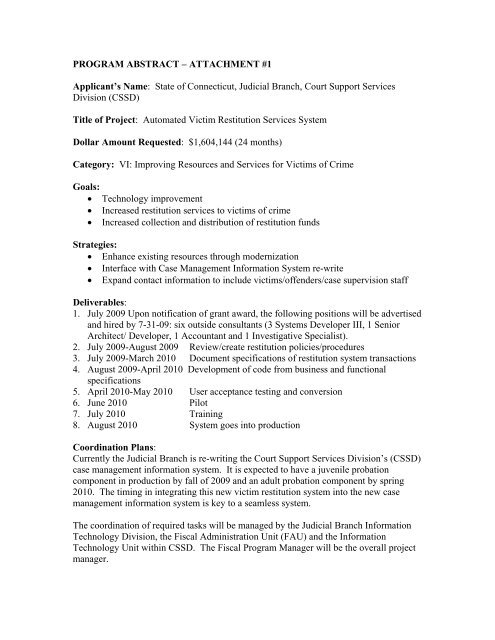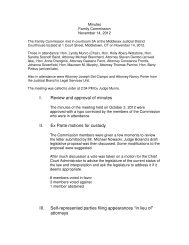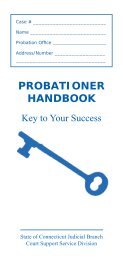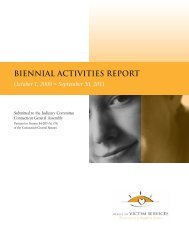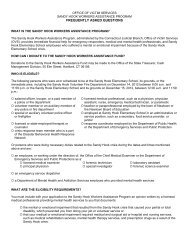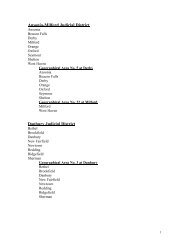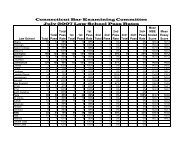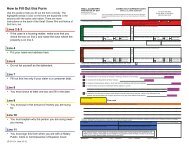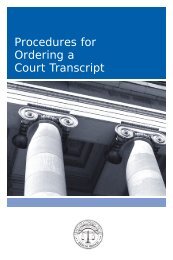Automated Victim Restitution Services Program Grant Proposal
Automated Victim Restitution Services Program Grant Proposal
Automated Victim Restitution Services Program Grant Proposal
Create successful ePaper yourself
Turn your PDF publications into a flip-book with our unique Google optimized e-Paper software.
PROGRAM ABSTRACT – ATTACHMENT #1<br />
Applicant’s Name: State of Connecticut, Judicial Branch, Court Support <strong>Services</strong><br />
Division (CSSD)<br />
Title of Project: <strong>Automated</strong> <strong>Victim</strong> <strong>Restitution</strong> <strong>Services</strong> System<br />
Dollar Amount Requested: $1,604,144 (24 months)<br />
Category: VI: Improving Resources and <strong>Services</strong> for <strong>Victim</strong>s of Crime<br />
Goals:<br />
• Technology improvement<br />
• Increased restitution services to victims of crime<br />
• Increased collection and distribution of restitution funds<br />
Strategies:<br />
• Enhance existing resources through modernization<br />
• Interface with Case Management Information System re-write<br />
• Expand contact information to include victims/offenders/case supervision staff<br />
Deliverables:<br />
1. July 2009 Upon notification of grant award, the following positions will be advertised<br />
and hired by 7-31-09: six outside consultants (3 Systems Developer III, 1 Senior<br />
Architect/ Developer, 1 Accountant and 1 Investigative Specialist).<br />
2. July 2009-August 2009 Review/create restitution policies/procedures<br />
3. July 2009-March 2010 Document specifications of restitution system transactions<br />
4. August 2009-April 2010 Development of code from business and functional<br />
specifications<br />
5. April 2010-May 2010 User acceptance testing and conversion<br />
6. June 2010 Pilot<br />
7. July 2010 Training<br />
8. August 2010 System goes into production<br />
Coordination Plans:<br />
Currently the Judicial Branch is re-writing the Court Support <strong>Services</strong> Division’s (CSSD)<br />
case management information system. It is expected to have a juvenile probation<br />
component in production by fall of 2009 and an adult probation component by spring<br />
2010. The timing in integrating this new victim restitution system into the new case<br />
management information system is key to a seamless system.<br />
The coordination of required tasks will be managed by the Judicial Branch Information<br />
Technology Division, the Fiscal Administration Unit (FAU) and the Information<br />
Technology Unit within CSSD. The Fiscal <strong>Program</strong> Manager will be the overall project<br />
manager.
PROGRAM NARRATIVE – ATTACHMENT #2<br />
Category: VI: Improving Resources and <strong>Services</strong> for <strong>Victim</strong>s of Crime<br />
(1) Statement of Problem<br />
<strong>Victim</strong>s of crime often suffer financial losses which are reimbursed through court ordered<br />
restitution levied against offenders. The current automated restitution management legacy<br />
system is over 17 years old, is costly to maintain and provides limited services to the courts and<br />
victims of crime. The current system provides no mechanism to communicate the status of the<br />
collection/disbursement of restitution to victims who find themselves involved in the criminal<br />
justice process. <strong>Victim</strong>s oftentimes feel “victimized” again by the inadequate sharing of<br />
information regarding victims’ rights, court case dispositions and offenders’ compliance with<br />
court ordered conditions, including the payment of restitution. The current system provides no<br />
valuable exchange of information between the victim and CSSD pertaining to a victim’s location<br />
which is a significant factor contributing to the more than $1 million in undistributed restitution<br />
monies now held by the State. Additionally, the current system provides minimal automated<br />
restitution account information to the offender, thereby contributing to decreased restitution<br />
collection.<br />
Improvements to services can be achieved through a newly designed <strong>Automated</strong> <strong>Victim</strong><br />
<strong>Restitution</strong> <strong>Services</strong> System. The business and functional specifications for this system have<br />
been completed. The coding and testing phases are the next steps in the process. In order to<br />
begin the coding phase, the creation of jobs is required. Four independent consultants will be<br />
needed to create and integrate the new <strong>Automated</strong> <strong>Victim</strong> <strong>Restitution</strong> <strong>Services</strong> System into<br />
CSSD’s Case Management Information System (CMIS). Three IT consultants will be at the<br />
Systems Developer III level and one consultant will be at a Senior Architect/Developer level.<br />
Page 1 of 8
These positions can be filled on July 31, 2009, with an anticipated system production date of<br />
August 2010.<br />
The dissemination of restitution and case management account information to offenders<br />
and victims will be completed through the issuance of monthly restitution statements containing<br />
pertinent information including, but not limited to, payments, balances, past due amounts,<br />
probation end date and the legal status of the offender (e.g. currently active, violation status,<br />
incarcerated, etc.). This proposal also seeks the funding of two independent consultants to be<br />
hired in the capacity of an Accountant and an Investigative Specialist. The Accountant will<br />
oversee the functionality of the accounting system component, data conversion, prototype testing<br />
and training. The Investigative Specialist would be dedicated to locating restitution victims of<br />
crime.<br />
(2) <strong>Program</strong> Design and Implementation<br />
The <strong>Automated</strong> <strong>Victim</strong> <strong>Restitution</strong> <strong>Services</strong> System will rely on the already completed<br />
business and functional project specifications. The hiring of the 6 individuals previously<br />
mentioned will take place immediately. The significant IT phases are coding, testing, user<br />
acceptance, project pilot and production. Following the August 2010 system production, three<br />
IT consultants (Systems Developer III) will not be needed as the Senior Architect/Developer will<br />
handle all maintenance and future design issues. The Accountant and Investigative Specialist<br />
will initially be trained on the existing legacy restitution system in order to provide<br />
developmental support to the IT staff.<br />
The Recovery Act provides funding to improve the criminal justice system by providing<br />
assistance to victims of crime. The proposed restitution system will maximize monetary<br />
outcomes to victims of crime by maintaining more frequent address verification and a full time<br />
Page 2 of 8
Investigative Specialist dedicated to locating restitution victims who cannot be found through<br />
traditional probation casework. These outcomes will be measured by the decrease in the volume<br />
of dollars “held” pending location of victims and a subsequent decrease in funds escheated to the<br />
State’s General Fund and/or Criminal Injuries Compensation Fund. If victims are receiving more<br />
funds due to an increase in restitution collection, the likelihood exists that these funds will be<br />
funneled back into the economy. The goal of providing assistance to crime victims through the<br />
services of the Investigative Specialist will require job creation and, by virtue of the continual<br />
existence of criminal activity, should result in job sustainability.<br />
If funded, this project will improve the public perception of the criminal justice system in<br />
that victims who feel that they do not have a “voice” in the process, and/or feel that supervisors<br />
of offenders are unresponsive or insensitive to the monetary loss they have experienced, will<br />
now have case and contact information available to them on a regular basis. <strong>Victim</strong>s of crime are<br />
an underserved population that stands to greatly benefit from improved communication from<br />
CSSD and a more efficient collection of restitution due to them. Supervision officers often have<br />
no alternatives to enforce restitution payment orders other than violation proceedings at the end<br />
of a probation period. The proposed system would produce monthly notification to supervision<br />
officers about offenders who have a restitution balance due and are within 90 days of the<br />
probation end date. Emphasis can be placed on collection of all restitution due prior to the end of<br />
the probation period, resulting in higher restitution collections and fewer violations of probation.<br />
The investment in technological advances will greatly improve communication on many<br />
different levels. The implementation of the proposed restitution system will provide “real-time”<br />
data to supervision officers regarding restitution account status. Supervision officers will be<br />
better equipped to make decisions about offender violations and will inherently provide more<br />
Page 3 of 8
accountability to victims of crime. The proposed <strong>Automated</strong> <strong>Victim</strong> <strong>Restitution</strong> <strong>Services</strong> System<br />
will offer consistent “dialogue “(via monthly statements) to victims which is important to victims<br />
in determining their monetary recovery timeline. The monthly statements will contain a text<br />
message area that will serve to keep victims informed about any changes in the legal status of the<br />
probationer’s case.<br />
Monthly offender statements, automatically generated through the new victim restitution<br />
system, will offer accurate and timely information regarding the restitution account. This<br />
improved system functionality will be a reinforcement of the conditions of probation and will<br />
result in a higher level of restitution collections. The monthly statements will also assist in<br />
tracking offender whereabouts, depending on whether the statements are received at the last<br />
known address, or returned undeliverable.<br />
A comprehensive timeline including milestones, numerically listed deliverables and the<br />
responsible party for each activity is contained in Attachment #4.<br />
(3) Capabilities/Competencies<br />
This is a proposed effort to include: the Judicial Branch’s Information Technology<br />
Division (ITD), CSSD IT Unit, CSSD Fiscal Administration Unit, Judicial’s Internal Audit, and,<br />
in a limited context, the Executive Branch Comptroller Office.<br />
The Judicial Branch Information Technology Division consists of over 90 staff. It is<br />
responsible for all technical issues for the Judicial Branch. This includes, but is not limited to,<br />
network security, server systems, standards maintained of all current systems and development<br />
of new systems. CSSD IT business unit has 6 business experts whose expertise in design,<br />
defining functionality of systems, testing systems and training from a business user perspective.<br />
Through the collaborative efforts of these two units, automated projects started to date have<br />
Page 4 of 8
made it to production including automations of violation of probation warrants to police<br />
departments throughout Connecticut, a complete case management system for juvenile detention,<br />
juvenile probation, juvenile court, adult probation, bail and family criminal staff for the State.<br />
Currently work is in progress on a redesign of CMIS to improve its functionality.<br />
ITD will have a Project Manager assigned to coordinate this project with CSSD. The<br />
Senior Architect/ Developer hired for this project will oversee the three Systems Developer IIIs<br />
and report to the Project Manager. The project will also have a project lead for a business<br />
perspective from CSSD IT, and the lead will work with a team of CSSD users to coordinate<br />
discussions with ITD during development and to follow the project through to production.<br />
CSSD has a Fiscal Administrative <strong>Services</strong> Unit which manages restitution collection and<br />
accounting and is comprised of a Manager, Fiscal <strong>Program</strong> Manager, Accountant and two<br />
Administrative Assistants. The Fiscal <strong>Program</strong> Manager will be the overall coordinator for this<br />
project. She has qualifications that include over 20 years experience in a variety of<br />
financial/management positions with emphasis on planning, designing and implementing<br />
automated accounting processes.<br />
The Judicial Branch maintains a process of centralized review, approval, and financial<br />
management with respect to grant programs, and a decentralized process with respect to actual<br />
grant-funded project operations. The Judge Support <strong>Services</strong> <strong>Grant</strong>s Management Unit will<br />
provide a central coordinating function for Branch-wide grant activity and provide oversight of<br />
program and fiscal activities including the transfer of funds and the timely recording of revenue.<br />
The draw downs of awarded funds are processed electronically into a separate account<br />
established in the state accounting system. Appropriate expenditures are posted against this<br />
Page 5 of 8
segregated account. The Judicial Branch has had years of experience in receiving and managing<br />
Edward Byrne Memorial <strong>Grant</strong> funds.<br />
(5) Impact/Outcomes, Evaluation, Sustainment, and Description of the Applicant’s Plan<br />
for the Collection of Data Required for Performance Measures<br />
The Connecticut Judicial Branch certifies its capacity and willingness to participate in an<br />
evaluation managed by the National Institute of Justice for its proposed project (<strong>Automated</strong><br />
<strong>Victim</strong> <strong>Restitution</strong> <strong>Services</strong> System) under the Edward Byrne Memorial Competitive <strong>Grant</strong><br />
Funding process. Capacity can be demonstrated by the existence of restitution data from our<br />
current system for the past several fiscal years. Historical data currently exists for:<br />
• <strong>Restitution</strong> collected in a fiscal year (7/1/07 – 6/30/08) from probationers (approximately<br />
$6,500,000 / 20,000 payments)<br />
• <strong>Restitution</strong> collected from probationers that has not yet been disbursed to victims of<br />
crime (approximately $1,000,000 / 2,200 cases pending on 3/31/09)<br />
• <strong>Restitution</strong> escheated annually to the General Fund (approximately $95,000)<br />
• <strong>Restitution</strong> escheated in an average fiscal year (7/1 – 6/30) to the Connecticut Criminal<br />
Injuries Compensation Fund (approximately $100,000 / 260 cases)<br />
Objective: Preserving jobs<br />
No impact.<br />
Objective: Creating jobs<br />
There are a total of 6 jobs that will be created with Recovery Act Funding.<br />
Collection method: Count and report the number of jobs created during the applicable reporting<br />
period.<br />
Page 6 of 8
Objective: Promoting economic recovery (essential services)<br />
The mission of improving services to victims of crime encompasses improved technology<br />
development and increased restitution collection/disbursement. This mission relies on<br />
maintaining the essential services already existing in the legacy system while creating the greater<br />
efficiencies of the <strong>Automated</strong> <strong>Victim</strong> <strong>Restitution</strong> <strong>Services</strong> System. This essential service would<br />
be enhanced with Recovery Act funding.<br />
Collection method: Reports on progress of system development, testing and implementation<br />
phases during the applicable reporting period. The essential service of restitution collection and<br />
disbursement would continue without disruption but the increase in restitution collection and<br />
disbursement due to Recovery Act funding will be reported.<br />
Collection method: Comparison of collection and disbursement activity before, during and after<br />
project implementation.<br />
Objective: Promoting economic recovery (collaborative partnerships)<br />
Collaborative partnerships would be created by partnering with all Branch Divisions responsible<br />
for services to victims of crime.<br />
Collection method: Report on units and agencies contacted, number of meetings and<br />
identification of parties on sub-committees (to be developed) during the applicable reporting<br />
period.<br />
Objective: Enhance or implement initiatives to reduce the incidence of violent crime or improve<br />
services to victims.<br />
This proposal seeks funding to maximize the monetary outcomes to victims of crimes and its<br />
effectiveness will be demonstrated through an increase in restitution dollars collected, a decrease<br />
of “held” restitution monies and a decrease in funds escheated annually.<br />
Page 7 of 8
Collection method: The data collected will include number of cases for which restitution was<br />
collected and the amount of restitution collected, amount of “held” monies and number of<br />
associated restitution cases, amount of monies escheated and number of corresponding cases.<br />
This data is currently captured through the restitution legacy system and the new <strong>Automated</strong><br />
<strong>Victim</strong> <strong>Restitution</strong> <strong>Services</strong> System will be designed to collect these statistics, but in an<br />
improved fashion. The determination of escheatable funds is currently a manual system and this<br />
function will be automated in the proposed system. Data will be complied by fiscal quarter and<br />
compared to historical data collected. The CSSD will submit quarterly reports analyzing trends<br />
and applicable percentage increases/decreases for the activity measured.<br />
The project will continue after the expiration of the federal grant award. The <strong>Automated</strong><br />
<strong>Victim</strong> <strong>Restitution</strong> <strong>Services</strong> System will be integrated into CMIS and maintenance and design<br />
changes will be handled internally. The performance data (e.g., higher restitution collection<br />
levels, lower levels of fund escheated, release of funds held to victims) will be utilized in the<br />
State of Connecticut’s budgetary process in that a legislative budget option for consideration of a<br />
August 2011 pick up of grant funded positions (3) will be introduced by the Judicial Branch.<br />
Additionally, the increased performance provided by this project will be used to propose a<br />
legislative change to add a surcharge to orders of restitution. The surcharge may be used to<br />
compensate those victims who are not fully compensated for financial losses (e.g. offender sent<br />
to jail, case disposed of with a balance of restitution due, offender dies prior to completing the<br />
condition of payment of restitution) as well as to support the administration costs of maintaining<br />
the <strong>Automated</strong> <strong>Victim</strong> <strong>Restitution</strong> <strong>Services</strong> System.<br />
Page 8 of 8
OMS APPROVAL NO. 1121-0188<br />
EXPIRES 5-98 (Rev. 1/97)<br />
Budget Detail Worksheet<br />
.Purpose: The Budget DetailWorl
c. Travel - Itelnize travel expenses ofproject personnel by purpose (e.g., staff to training, field<br />
illterviews, advisory group Ineeting, etc.). Show the basis ofcomputation (e.g., six people to 3-day<br />
training at $X airfare, $X lodging, $X subsistence). In training projects, travel and meals for trainees<br />
should be listed separately. Show the nUlnber oftrainees and the Ullit costs involved. Identify the<br />
location oftravel, ifknown. Indicate source ofTravel Policies applied, Applicant or Federal Travel<br />
Regulatio11s.<br />
Purpose ofTravel Location Item Computation Cost<br />
TOTAL $3,844.00<br />
'D. Equipment - List non-expendable items that are to be purchased. Non-expendable equipment<br />
is tangible property having a useful life ofmore than two years and an acquisition cost of$5,000 or<br />
more per unit. (Note: Organization's own capitalization policy may be used for items costing less than<br />
$5,000). Expendable items should be included either in the "supplies" category or in, the "Other"<br />
category. Applicants should analyze the cost benefits ofpurchasing versus leasing equipment, especially<br />
high cost items and those subject to rapid technical advances. Rented or leased equipment costs<br />
should be listed in the "Contractual" category. Explain how the equipment is necessary for the success<br />
oftIle project. Attach a narrative describing the procurement method to be used.<br />
Item<br />
Computation<br />
Cost<br />
IEquipment entry 1 No Expenses<br />
$0.00<br />
leqiupment entry 2<br />
leqUiPment entry 3<br />
lequiPment entry 4<br />
Iequipment entry 5<br />
TOTAL $0.00<br />
-----
E. Supplies - List items by type (office supplies, postage, training materials, copying paper, and<br />
expendable equipment itelTIS costing less that $5,000, such as books, hand held tape recorders) and<br />
s110w tIle basis for computation. (Note: Organization's own capitalization policy may be used for<br />
itelTIS costing less than $5,000). Generally, supplies include any Inaterials that are expendable or<br />
consumed during the course ofthe project.<br />
Supply Items Computation Cost<br />
ISUPPIY item 1 Laptop Computers<br />
16 computers & monitors (6 x 1500)<br />
1$9,000.00<br />
~================= 1$600 per consultant (6x600)<br />
ISUPPIY item 2 Office Furnishings<br />
ISUPPIY item 3 Office supplies<br />
$50 per month per consultant (50 x 6 x 23)<br />
1$3,600.00<br />
$6,900.00<br />
ISUPPIY item 4<br />
ISUPPIY item 5<br />
ISUPPIY item 6<br />
ISUPPIY item 7<br />
ISUPPIY item 8<br />
supply item 9<br />
TOTAL$19,500.00<br />
F. Construction - As a rule, construction costs are not allowable. In some cases, minor repairs or<br />
renovations may be allowable. Check with the program office before budgeting funds in this<br />
category.<br />
Purpose Description ofWork Cost<br />
INOExpens_es 1------------11---1<br />
______-----------11 1<br />
_________-----------11 1<br />
----------__---------.111---<br />
TOTAL$0.00<br />
-----
G. Consultants/Contracts - Indicate whether applicant's formal, written Procurelnent Policy or<br />
the Federal Acquisition Regulations are followed.<br />
Consultant Fees: For each consultant enter tIle name, ifknown, service to be provided, hourly or daily<br />
fee (8-hour day), and estilnated time on the project. Consultant fees in excess of $450 per day require<br />
additional justification and prior approval from OJP.<br />
Narne of Consultant<br />
Isystem Developers III (3 @ $75 per hour)<br />
Isenior Architect/Developer (1 @ $90/hour)<br />
IAccountant (1 @ $90/hour) IOversight of financial aspects of<br />
---------------- restitution project<br />
Service Provided Computation Cost<br />
IDevelop Code, Convert Data and Design 13 x $75 x 40 hrs x 56iii 1$504,000.00 1<br />
interface.<br />
Ix $90 x 40 hrs x 104\\d1$374,400.00 I<br />
I Oversee system developers and<br />
supervision design, code and date<br />
a<br />
I~X-$-9-0-x-40-h-rs-x-10-4\\d 1$374,400.00<br />
1Investigative Specialist (1 @ $75/hour) ILocate victims of crime, not found through 1 x $75 x 40hr x 10411 1$306,000.00 I<br />
L--------------..I·traditional casework<br />
S bt 1 $1,558,800.0<br />
u ,ota -----<br />
Consultant Expenses: List all expenses to be paid from the grant to the individual consultallts in<br />
addition to their fees (i.e., travel, meals, lodging, etc.)<br />
Item Location Computation Cost<br />
Iconsultant expense entry 1, one line p~lmaximum of three lines<br />
I<br />
I<br />
II======~=====~===<br />
II======~=======;~==~<br />
II maximum of three lines<br />
Iconsultant expense entry 1, one line p~lmaximum of three lines<br />
Subtotal $0.00<br />
-----<br />
Contracts: Provide a description ofthe product or service to be procured by contract and an estilnate<br />
ofthe cost. Applicants are encouraged to prOlTIote free and open competition. in awardin.g contracts.<br />
A separate justification must be provided for sole source contracts in excess of$100,000.<br />
I<br />
Item<br />
maximum of four lines, additional information should be attached on a sepa·rate sheet(s)<br />
Cost<br />
I<br />
maximum of four lines<br />
""'____,-- --1<br />
I<br />
Subtotal $0.00<br />
-----<br />
TOTAL $1,558,800.0<br />
I
:Budget Summary- When you have completed the budget worksheet, transfer the totals for each<br />
category to the spaces below. Compute the total direct costs alld the total project costs. In.dicate the<br />
alTIOunt ofFederal requested and tIle amount ofnon-Federal funds that will support the project.<br />
Budget Category<br />
A.Personnel<br />
B. Fringe Benefits<br />
C. Travel<br />
D. Equipment<br />
E. Supplies<br />
F. Construction<br />
G. Consultants/Contracts<br />
H.. Other<br />
Total Direct Costs<br />
1. Indirect Costs<br />
TOTAL PROJECT COSTS<br />
Amount<br />
$0.00<br />
$0.00<br />
$3,844.00<br />
$0.00<br />
$19,500.00<br />
$0.00<br />
$1,558,800.00<br />
$22,000.00<br />
$1,604,144.00<br />
$0.00<br />
$1,604,144·Ci<br />
Federal Request<br />
$1,604,144.00<br />
Non-Federal Amount


